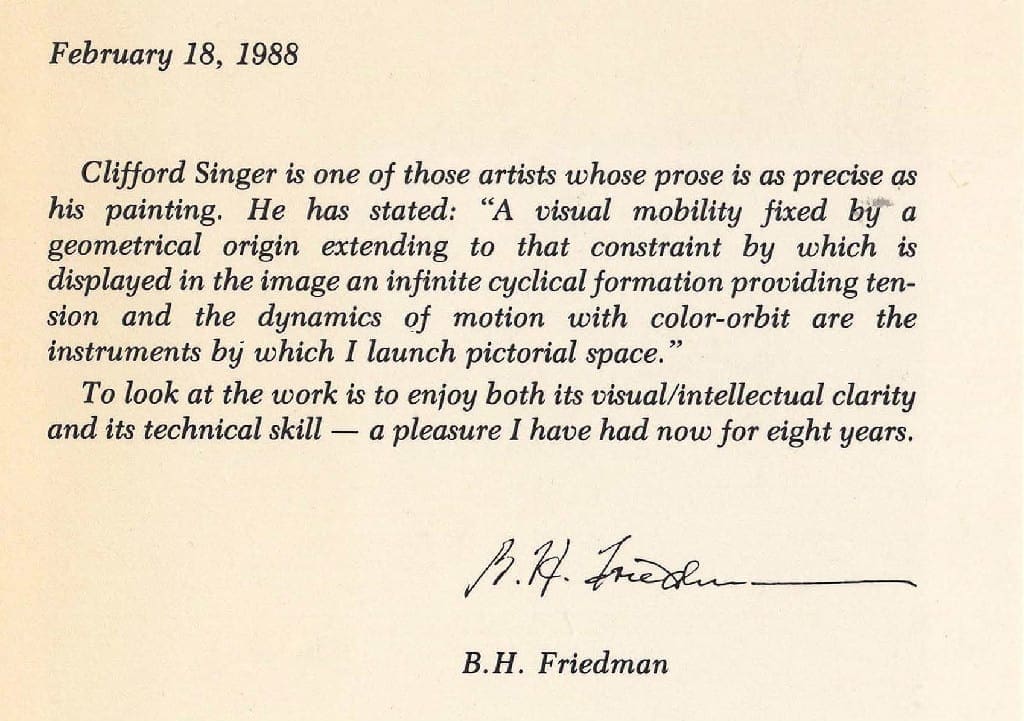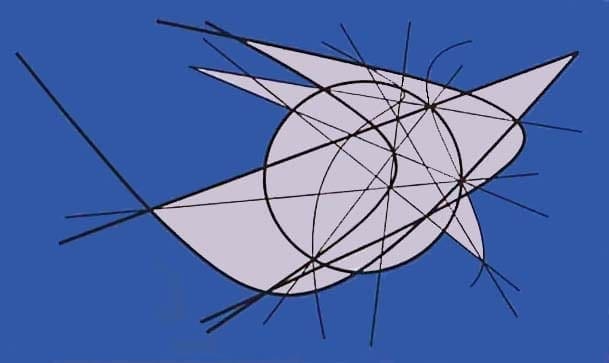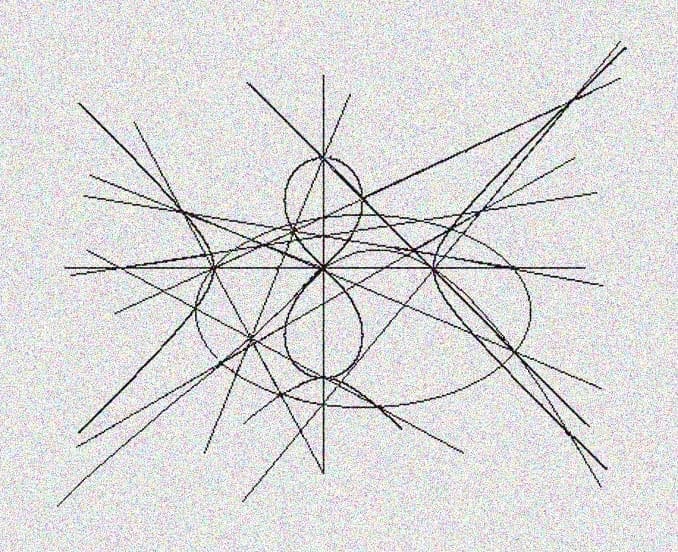Clifford Singer: The Master of Geometrical Art
Statements

2022 Nevada Public Radio, Desert Companion Magazine, ART, Geometrical Clouds, by Andrew Kiraly, Page 33

Clifford Singer, "Your artwork stands on it's own."
Howard Rubenstein, PR, 1991
"Your artworks present a warm, pleasing, well, organized family of forms."
Roman Verostko , December 2017
JMM 2018, Exhibition of Mathnematical Art, January 10-13, San Diego Convention Hall
http://gallery.bridgesmathart.org/exhibitions/2018-joint-mathematics-meetings/clifford-singer
"I am fascinated by your use of Differential Geometry and your application of a mathematical construction of planar curves and surface of classical geometry and graphing them linearly.
The transformation from math to beautiful artworks of a topological landscape is truly magical." Irene Rousseau,© November 2017
Clifford Singer, Cut Space Series, © 2011, Installation at Las Vegas studio
“As models -- these paintings represent a space time continuum, the singularity of beginning and end points are of an anomaly. In the paintings I suggest the dynamics of a space that continually expands the structural space and geometrical fragmentation in space-time from a Big Bang. Line segments in the universe are interconnected, even when they appear to be separate from one another. In space-time curvature the geometrical strain illustrates a deformation of space. In the art one can identify a time axis with our world line. So, pursued through painting, works of art is a structured space perceived in space-time yields the image.” Clifford Singer © 2011
Essay by Stanley Fogel, New York, 2011 Former Financial Analyst, Federal Reserve Bank
"Clifford Singer specializes in bringing the insights of advanced mathematics; topology and algebraic geometry; into concrete artistic form. In his latest work "Cut Space Series # 76" he evokes the form of the early universe as it explodes outward in its first nanoseconds of existence. In this exploding infant universe one can almost see the trajectories of subatomic particles that are brought into existence as the symmetry of unity is broken into the four fundamental forces. And yet, even then, one can envision the newly liberated shards of matter pulling back on each other as gravity emerges from its primordial quantum state." Stanley Fogel © 2011
Facebook Wall

Kenneth Snelson
Hi Cliff, Lots of beautiful work. Thanks for letting me know about the videos. Best, Ken

Beauty of geometric constructions in the art of Clifford Singer @MammothArt
cliffordsinger.net

Clifford Singer: The Master of Geometric Art

Clifford Singer, The Blue Rider © 2001, Acrylic on Plexiglas, 25 x 42 inches

Concerning the Geometrical In Art
by Clifford Singer © 2002
It is the expanse of thought from earlier twentieth-century Modern art that has been in part an inspiration to my recent painting entitled, The Blue Rider. There is History serving as a discipline and the elements that shape the boundaries of style, vision, repetition, method, and constraint in art. This is the role of suggestibility for our perceptions. Expression is not isolated, limited, or confined to a single notion, or arbitrary method. To escape from the perpetual forces of society, tradition, and attitude would be to escape History itself. Wassily Kandinsky and Franz Marc who formed the Blaue Reiter group brought the spiritual and mystical to art as an emphasis towards a pure expression in Modern painting. Blaue Reiter having a main objective, the future, awakening the realization and understanding of the spiritual essence found in all things. The members of the group had held the position that colors and particularly the color blue has an inward spiritual significance. A process that is introspectively palpable and its individuated, continual, motivated, thematic, imaginative integration of geometrical configuration with color serves as a vehicle to this discipline. The color blue serves as a signature for the only major twentieth-century movement to include a color as its designated center of thought. Color, a sine qua non of art, is the most difficult component of the work to capture. Blue as a sine qua non color of Western twentieth-century represents tranquility and truth. Platonically, the color blue and geometry are equally abstract to each other, which are well suited for my visual device. The color blue itself is not subordinate to or bounded by lines, but rather takes on and describes its own clarity for congruence. Black and white as colors set extremes of color and discussed by Ludwig Wittgenstein as being colors in themselves anchor and balance the pictorial field.
Professor Joel Castellanos, Department of Mathematics and Computer Science, Director of NonEuclid at Rice University, has stated, “I am especially drawn to [Clifford Singer’s painting entitled] The Blue Rider. The lines move me in and around and are suggestive of so many different things and actions, yet never settle anywhere.”
The visual field is scientifically exact as far as measure, and as a universal platform for individual expression that is erected as a whole and complete structure for this creative enterprise. As a visual mathematician I recognize the existence of a naïve spirituality applied through creative process. Where the process begins and ends is open for much discussion. Geometry being empirical narrows the framing of the image to an immediate experience to the picture plane. The science of geometry and its modern developments may be one of the most original creations derived from the human spirit.
The language of geometry is abstract and formal that I have re-invented for my artworks. It has been widely thought that the certainty of the characteristics of number, and structure in mathematics is reason for the certainty of our geometrical knowledge of the space of the physical universe. The question of geometry as mathematical object remains a major concern. Demonstration of collinear points distinguishes the visual format and formulation for the basis of the work.
Is geometrical art an applied science? There reigns a certain pre-established harmony in geometry, what is required in one line of thought is supplied in another line, so that there appears to be a logical necessity, independent of our individual disposition. It is not in the formalist’s mode of thought to deal mainly with the skilful formal treatment of a formal question to devise an algorithm. But, it is rather for the intuitionists who give particular emphasis and stress on geometrical intuition in general and not to give a complete account of a specific subject area. An additive construction as a supplement to a range of mathematical views that I find prevalent through geometrical thinking as to gain insight into the shape of curves as far as general classification and an enumeration of all fundamental forms are concerned.
All this suggests, is the question whether it would not be possible to create an abridged system of mathematics that is adapted to the needs of the applied sciences, without passing through the whole realm of abstract mathematics. It is my general aim to gain, in the course of time, a complete view of the whole field of mathematics with particular regard to the intuitional or in the highest sense of the term: geometrical standpoint.
What is the distinction between a naïve and refined intuition? It must be stated that the root of the matter is that naïve intuition is not exact. While the refining of intuition is not properly intuition at all, however, arises through a rational development of axioms considered as being perfectly correct. To further describe our naïve intuition, for example when thinking of a point we do not picture in our mind an abstract mathematical point, but rather substitute something visual and concrete in its place. In imagining a line, we do not picture in our minds a length without breadth, but however a strip of a particular width. We can always imagine a tangent as a straight strip having a small portion or point in common with a curved strip; similarly with respect to an osculating circle or variable curvature.
The curves and straight lines are of mathematical origin. There is an aesthetic selection for a particular mathematical curvature for a composition itself and are not necessarily mathematically driven or having a mathematical thrust (as a research mathematician may solve as particular problem) although the overall structure can be broken down line by line into mathematical expressions – geometric proofs and partial differential equations. As an artist using geometrical elements for the work I rely on classical construction methods. I have developed methods of construct for epicycloids (such as found in my painting Limacon), spirals (such as my painting The Geometry of the Circle, Square and Heart), parabolas, hyperbola and other curvatures as may be needed while doing my research. The process to plot a parabola by computing the plotting of nodes exponentially or any other creative measure as it presents itself. Creative thinking becomes asymptotic.
In many of my earlier works, I would start with a square panel and began drawing with compass and ruler. Quartic, a painting I created in 1999 was used for the front cover of FOCUS, The Mathematical Association of America, December 2000 featuring an article by Ivars Peterson on the exhibition Art & Mathematics 2000 where I was Curator at The Cooper Union. Quartic was quite difficult to construct as well as The Geometry Lesson done in 1998. In my paintings of recent years, I usually begin with a specific curvature, ellipse, etc. and start working with it planning space. There is much trial and error in this process. I find the intersections of three, four, and five fold as both intuitive and of rational process as I build the image. Of course, I go through many algorithms both numeric equation and visual as I build the picture plane. The steps that I go through visually are in finding the straight line, parabola, or composition of curves (combining two curves as one) that will work within my system of collinear plotting. As the composition is built within my visual system, I find a minimum of three points of intersection for a given line, which requires three, four, or five fold per intersection. This is how I achieve the interweaving of the lines for my compositions. The lines are drawn in a sequential order although it is not the final result. The final result is discovery of the geometries from the invisible. I have been doing geometric paintings, prints and sculptures since 1972 and find that working with geometry over decades has become second nature.
In order to validate the work of art we must give attention not only to the numerous complex aesthetic issues but also to a real underlying nature supportive to the picture plane. In this matter we are fundamentally concerned with the intrinsic network of thought determined by a direct uniform property. Such is a coplanar family of lines that pass through a common vertex. To every property in relation to each other, which points can have, there corresponds some locus, which consists of all the points possessing the property.
The picture plane is the resolve for these matters. Of course one may perceive through a classical viewpoint of analysis that encompasses symmetrical, approximate, asymmetrical, and radial properties as well as the elements and principles of design that I am visually suggestive of as a unified and harmonious composition. Based on physical law, one can reach approximate zero gravity while traveling along a parabolic curvature within the earth’s atmosphere and gravitational pull. Fast and slow curves accelerate speed of eye while looking at the painting. Can visual perception reach zero gravity within the picture plane for the viewer? Artistic expression is found in personal vision and realms of consciousness. Issues of aesthetics may not necessarily be entirely rooted in beauty and judgment, but may fall into the realm of praxis.
I have distinguished in this module, the mechanics of geometrical expression in Non-Euclidean space, which parallels and brings beauty, visual order, and mathematical realities into view. These properties are operative on a universal scale. Change, adaptation, and reassigning values for solutions to problems are key to geometrical demonstration. As a geometer artist having mechanical drawing instruments I might compare and contrast in some respects to the archer with the use of the bow where the target is the resolve. Aesthetic and technical experience in drawing increases my understanding and appreciation of the picture plane, thus the completion of the idea complex. The quantification of nature as expressed on the picture plane may define physics such that the state of reality explicitly and tangibly varies according to the mathematics through which one notices or apprehends it. Acquired dexterity, sensitivity, and mastery of technique have taken control of the medium.
The tendencies thus characterized have exerted a wide-felt influence, and give a distinctive character to a large part of our present geometrical investigations into visual art.
Towards a Geometrical Way of Thinking
by Clifford Singer ©2002
Bridges: Mathematical Connections in Art, Music and Science 2002
Is it that we discover and use mathematical definitions to further connect and validate geometrical understandings from an artistic perspective?
The scientist must go through a filtering of abstract descriptions to reach a concrete reality and the geometer/artist must, as is common to the mathematician’s use of the branches of mathematics, present an illustration based in visual art. All disciplines of visual art enable the geometer/artist to gain a foothold through creative process into a belief that a fixed state for the geometrical diagram is artistic imagery. We find something so tangible set into art materials and thus into time representing essential structures found on a universal scale whether they be real or imaginary. Fragments of the infinite past, present, future distinguishes a system of numeration in space-time yielding an intuitive picture thus exchanged for a symbolic and geometrical construction.
Exploration into a geometrical way of thinking of vectors, curvature and the introduction of properties, manipulation of visual enterprise as geometer/artist informs the viewer on dissection and algorithmic thinking. This lends proof for geometrical thought and visual experience. Jack Tworkov viewed his Knight Moves series of paintings during the 1970’s as he stated “vectors for mental exercise.” Tworkov’s paintings were derived from playing Chess. To work geometrically, one needs to create pictures from the mind and demonstrate by drawing this vision on paper. Sometimes one needs to draw them precisely, using mechanical tools by hand and/or with computer prosthesis. To reason about shape, space, line, form, and dimension requires good discipline of mind: where one must imagine, compute, observe, describe, and demonstrate.
According to Poincaré, although scientific theories originate from experience, they are neither verifiable nor falsifiable by means of the experience alone. For example, look at the problem of finding a mathematical law that describes a given series of observations. In this case, representative points are plotted graphically, and then a simple curve is interpolated. The curve chosen will depend both on the experience which determines the representative points and on the desired smoothness of the curve even though the smoother the curve the more that some points will miss the curve. Therefore, the interpolated curve is not a direct generalization of the experience, for it corrects the experience. In this sense, there is always a necessary difference between facts and theories, and therefore a scientific theory is not directly falsifiable by the experience.
The collections of geometrical drawings and models, and this discussion are designed to shape, in part, and always direct the right for the achievement of the individual’s expression.

Clifford Singer, Lemniscate, 2002©, Etching on paper, 16 x 20 inches
Geometrical Art as an Applied Science
by Clifford Singer © 2003
Abstracts of Papers Presented to the
Mathematical Association of America
Boulder MathFest
July 31 - August 2, 2003
Is geometrical art an applied science? There reigns a certain pre-established harmony in geometry, what is required in one line of thought is supplied in another line, so that there appears to be a logical necessity, independent of our individual disposition. It is not in the formalist’s mode of thought to deal mainly with the skilful formal treatment of a formal question to devise an algorithm. But, it is rather for the intuitionists who give particular emphasis and stress on geometrical intuition in general and not to give a complete account of a specific subject area. An additive construction as a supplement to a range of mathematical views that I find prevalent through geometrical thinking as to gain insight into the shape of curves as far as general classification and an enumeration of all fundamental forms are concerned. All this suggests, is the question whether it would not be possible to create an abridged system of mathematics that is adapted to the needs of the applied sciences, without passing through the whole realm of abstract mathematics. It is my general aim to gain, in the course of time, a complete view of the whole field of mathematics with particular regard to the intuitional or in the highest sense of the term: geometrical standpoint.
What is the distinction between a naïve and refined intuition? It must be stated that the root of the matter is that naïve intuition is not exact. While the refining of intuition is not properly intuition at all, however, arises through a rational development of axioms considered as being perfectly correct. To further describe our naïve intuition, for example when thinking of a point we do not picture in our mind an abstract mathematical point, but rather substitute something visual and concrete in its place. In imagining a line, we do not picture in our minds a length without breadth, but however a strip of a particular width. We can always imagine a tangent as a straight strip having a small portion or point in common with a curved strip; similarly with respect to an osculating circle or variable curvature.

Clifford Singer, Cut Space Composition #9, ©2002, Etching on paper, 16 x 20 inches